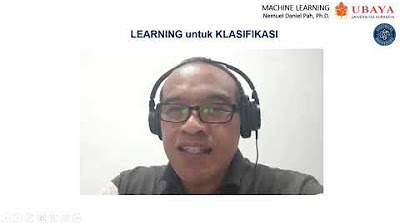Lec-5: Logistic Regression with Simplest & Easiest Example | Machine Learning
Summary
TLDRIn this video, the concept of logistic regression is explained, focusing on its application in binary classification. The presenter compares logistic regression with linear regression, highlighting that while linear regression predicts continuous values, logistic regression is used to predict categorical outcomes, like pass/fail. Key concepts such as dependent and independent variables, the sigmoid function, and the calculation of probabilities are discussed. The process of model optimization through Maximum Likelihood Estimation (MLE) and Gradient Descent is also covered. The video provides practical examples, demonstrating how logistic regression classifies data based on calculated probabilities.
Takeaways
- 😀 Logistic Regression is a classification model used in Supervised Learning to predict categorical outcomes (e.g., pass/fail, spam/not spam).
- 😀 Unlike Linear Regression, which predicts continuous values, Logistic Regression predicts binary outcomes (0 or 1).
- 😀 The key difference between Linear and Logistic Regression is the nature of the dependent variable: continuous in Linear, categorical in Logistic.
- 😀 The **Sigmoid function** is used in Logistic Regression to map predictions to probabilities between 0 and 1.
- 😀 Logistic Regression is typically used when the goal is to classify data into two categories based on an independent variable (e.g., hours studied).
- 😀 The output of a Logistic Regression model is a probability that falls between 0 and 1, representing the likelihood of a particular event (e.g., passing an exam).
- 😀 The model uses **Maximum Likelihood Estimation (MLE)** to optimize the parameters (intercept and coefficients).
- 😀 **Gradient Descent** is used to minimize the cost function and adjust model parameters for better predictions.
- 😀 In the example, if a student studies for 5 hours, the probability of passing is approximately 81%, while studying for 1.5 hours results in a 35% chance.
- 😀 The logistic regression equation for predicting probabilities is: P(y=1 | x) = 1 / (1 + e^-(a0 + a1 * x)), where a0 is the intercept, a1 is the coefficient, and x is the independent variable.
- 😀 Logistic Regression models binary outcomes by classifying data into categories (e.g., pass vs. fail) based on probability thresholds (e.g., > 0.5 for passing).
Q & A
What is logistic regression used for?
-Logistic regression is used for supervised learning in classification problems. It is commonly used to predict binary outcomes, such as whether an email is spam or not, or whether a student will pass or fail based on certain features.
How does logistic regression differ from linear regression?
-In linear regression, the dependent variable is continuous, meaning it can take any value (e.g., predicting house prices). In logistic regression, the dependent variable is categorical, typically binary, meaning it has two possible outcomes (e.g., pass/fail or spam/not spam).
What is the role of the independent variable in logistic regression?
-The independent variable(s) in logistic regression are the features that help predict the dependent variable. These could be multiple variables (e.g., study hours, age, income), and they assist in determining the probability of the outcome belonging to one of the categories.
What does the sigmoid function do in logistic regression?
-The sigmoid function in logistic regression transforms the raw predicted value (logit) into a probability between 0 and 1. This probability indicates the likelihood of the event belonging to a particular category (e.g., pass or fail).
Can logistic regression handle more than one independent variable?
-Yes, logistic regression can handle multiple independent variables. These are typically combined to form a linear combination that is then passed through the sigmoid function to predict the probability of a certain outcome.
What is the significance of the coefficients (a0, a1) in the logistic regression model?
-In logistic regression, a0 is the intercept, and a1 is the coefficient of the independent variable. The intercept represents the predicted probability when the independent variable is zero, and the coefficient determines how much the probability changes with each unit increase in the independent variable.
What is the decision threshold in logistic regression?
-The decision threshold in logistic regression is typically set to 0.5. If the predicted probability is greater than 0.5, the outcome is classified as belonging to the positive class (e.g., pass). If it is less than 0.5, it is classified as belonging to the negative class (e.g., fail).
What does the probability value represent in logistic regression?
-In logistic regression, the probability value represents the likelihood that a given instance belongs to the positive class. For example, a probability of 0.81 means there is an 81% chance that the outcome will belong to the positive category (e.g., passing a test).
How do you interpret the output when the probability is above 0.5?
-When the predicted probability is above 0.5, the model classifies the instance into the positive class. For example, if the probability is 0.81, the model predicts that the student will pass the exam (if passing is defined as the positive class).
What is the method used to find the best-fit values in logistic regression?
-The best-fit values in logistic regression are found using **maximum likelihood estimation (MLE)**, which estimates the parameters that maximize the likelihood of the observed data. The parameters are optimized using methods like **gradient descent** to minimize the cost function.
Outlines

This section is available to paid users only. Please upgrade to access this part.
Upgrade NowMindmap

This section is available to paid users only. Please upgrade to access this part.
Upgrade NowKeywords

This section is available to paid users only. Please upgrade to access this part.
Upgrade NowHighlights

This section is available to paid users only. Please upgrade to access this part.
Upgrade NowTranscripts

This section is available to paid users only. Please upgrade to access this part.
Upgrade NowBrowse More Related Video
5.0 / 5 (0 votes)





